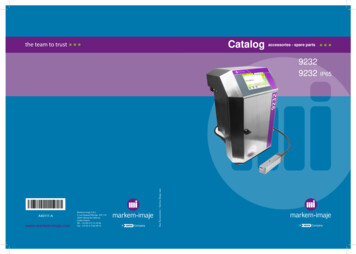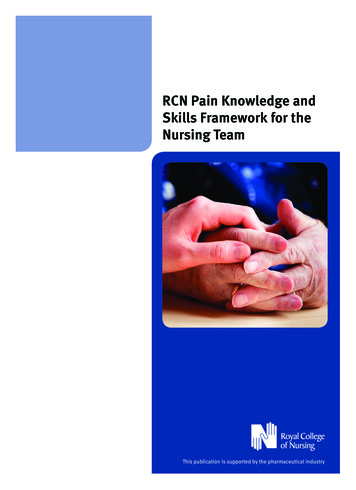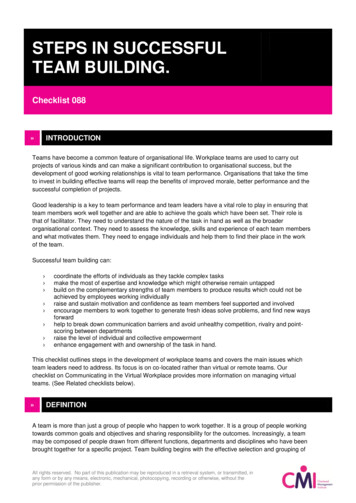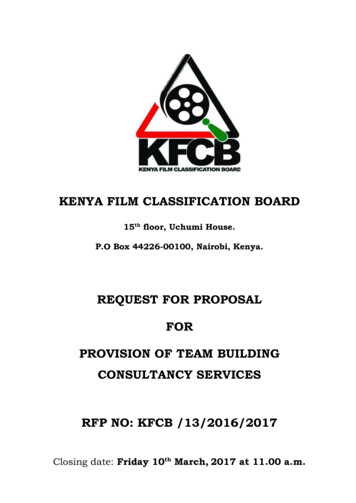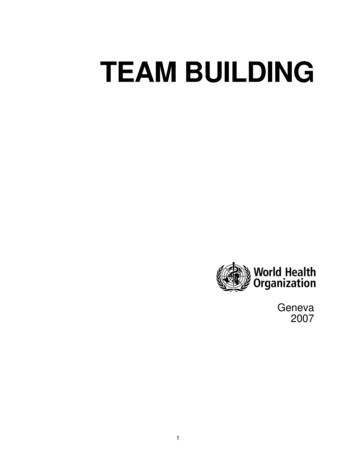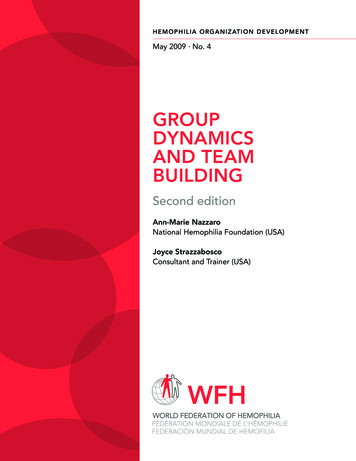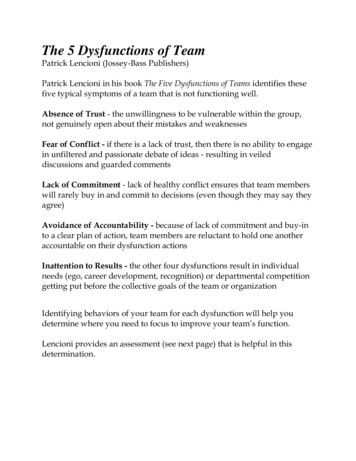
Transcription
The 5 Dysfunctions of TeamPatrick Lencioni (Jossey-Bass Publishers)Patrick Lencioni in his book The Five Dysfunctions of Teams identifies thesefive typical symptoms of a team that is not functioning well.Absence of Trust - the unwillingness to be vulnerable within the group,not genuinely open about their mistakes and weaknessesFear of Conflict - if there is a lack of trust, then there is no ability to engagein unfiltered and passionate debate of ideas - resulting in veileddiscussions and guarded commentsLack of Commitment - lack of healthy conflict ensures that team memberswill rarely buy in and commit to decisions (even though they may say theyagree)Avoidance of Accountability - because of lack of commitment and buy-into a clear plan of action, team members are reluctant to hold one anotheraccountable on their dysfunction actionsInattention to Results - the other four dysfunctions result in individualneeds (ego, career development, recognition) or departmental competitiongetting put before the collective goals of the team or organizationIdentifying behaviors of your team for each dysfunction will help youdetermine where you need to focus to improve your team’s function.Lencioni provides an assessment (see next page) that is helpful in thisdetermination.
Lencioni’s Fifteen Functional Team SkillsRate your team 1 Rarely, 2 Sometimes, 3 Usually1) Team members are passionate and unguarded in their discussion ofissues.2) Team members call out one another’s deficiencies or unproductivebehaviors.3) Team members know what their peers are working on and how theycontribute to the collective good of the team.4) Team members quickly and genuinely apologize to one another whenthey say or do something inappropriate or possibly damaging to theteam.5) Team members willingly make sacrifices (such as budget, turf, headcount) in their departments or areas of expertise for the good of theteam.6) Team members openly admit their weaknesses and mistakes.7) Team meetings are compelling and not boring.8) Team members leave meetings confident that their peers arecompletely committed to the decisions that were agreed upon, even ifthere was initial disagreement.9) Morale is significantly affected by the failure to achieve team goals.10) During team meetings, the most important - and difficult - issues areput on the table to be resolved.11) Team members are deeply concerned about the prospect of lettingdown their peers.12) Team members know about one another’s personal lives and arecomfortable discussing them.13) Team members end discussions with clear and specific resolutions andcalls to action.14) Team members challenge one another about their plans andapproaches.15) Team members are slow to seek credit for their own contributions, andquick to point out the contributions of others.
Scores for statements 4, 6, and 12 relate to Absence of Trust. Scores for statements 1, 7, and 10 relate to Fear of Conflict. Scores for statements 3, 8, and 13 relate to Lack of Commitment. Scores for statements 2, 11, and 14 relate to Avoidance of Accountability. Scores for statements 5, 9, and 15 relate to Inattention to Results. A score of 8 or 9 is probable indication that the dysfunction is not aproblem for your team.A score of 6 or 7 indicates that the dysfunction could be a problem.A score of 3 to 5 is probably an indication that the dysfunction needs to beaddressed.Fortunately, Lencioni also offers us a general prescription of actions we cantake to heal the dis-ease of the dysfunctional team, working at eachsymptom level.Absence of Trust Healing Activities Personal History Exercise - a simple round-the-table of each personsharing some information about his/her life - this does not need to bedeep personal disclosure. This is meant to open people to havinggreater empathy and understanding for each other and can also helpavoid unfair and inaccurate behavioral attributions.
Team Effectiveness Exercise - each team member identifies the singlemost important contribution that each peer makes to the team, as well asone area each team member could improve. One at a time, teammembers receive this input from their peers. Doing this by writing thisacknowledgment and constructive suggestion on a sheet of paper that isgiven to the recipient will help the person to process the informationmore later, as well as being able to have a concrete reference of the inputto refer to later for discussion with the giver of the information. Personality and Behavioral Preference Profiles - there are many. Just besure that the person delivering the assessments is experienced with theprofile as well as with the interpretation and delivery. 360 Feedback - this is best when completely divorced fromcompensation and formal employee performance evaluations.Fear of Conflict Healing Activities Mining - a miner in this situation is someone who extracts burieddisagreements and sheds the light of day on them, with sensitivity andtact. The team then works together to clear and resolve thedisagreement. Real Time Permission - permission to interrupt when a team member isbecoming uncomfortable with discord and offer encouragement thathealthy debate and discussion is important to trust. Assessment tools, Conflict Resolution and Negotiation workshops.
Lack of Commitment Healing Activities Cascading Messaging - reviewing at the end of meetings the keydecisions, creating agreement on what should be communicated outsidethe team, as well as what needs further clarification before action can betaken - focused on aligning everyone on the same outcomes. Timelines - setting reasonable timelines for completion of actions,making sure all are clear on the commitments and the times. Contingency and Worst Case Scenarios - helps to reduce fear by creatingoptions and exploring the worst potential and how to avoid it. Low Risk Exposure Therapy - substantial discussion often yields resultsas good as or better than results after extended research or analysis(which are often over-rated by dysfunctional teams) - by being decisivein low risk situations and following through, teams learn that they cantake risks and action and get positive results.Avoidance of Accountability Healing Activities Publish Goals and Standards - ambiguity is the enemy of accountability,clarity is its ally. When agreements are in the open, it is difficult if notimpossible to ignore them. Simple and Regular Process Reviews - regular review and feedback onwhat is working, what is not working. Team Rewards - in addition to individual acknowledgment andrecognition, creating team awards, earned together, bonds the team.
Inattention to Results Healing Activities Public Declaration of Results - committing to results to the public (therest of the organization, other departments, stockholders, uppermanagement, etc.) commits the team to success and doing whatever ittakes to get the results. Advising the public of the results after the factacknowledges and recognizes the team’s accomplishments, which helpsto create pride in the team and in the results. Results-Based Rewards - make bonuses and other kinds ofcompensation results dependent.Also vital to the process of creating a functional team is the importance ofregular, frequent team meetings, with updates and accountability as wellas creativity in approaching problem solving, critical thinking and decisionmaking.Addressing the areas where your team is dysfunctional will allow you tobuild a healthy team body and spirit. Left alone, like all other dis-ease, thedysfunction will fester and spread. Take action now and begin the healingof your team as preventative measures for the long life of your team.PS - If you think you got everything from the book here, I encourage you toread the story that is the main content of the book to inspire you toimplement these concepts.
The 5 Dysfunctions of Team Patrick Lencioni (Jossey-Bass Publishers) Patrick Lencioni in his book The Five Dysfunctions of Teams identifies these five typical symptoms of a team that is not functioning well. Absence of Trust - the unwillingness to be vulnerable within the group, not genuinely open about their mistakes and weaknesses
